Wrappers for the Soul
Ghostwire: Tokyo provides players a taste of Japanese folklore, urban legends, and more on a visually stunning stage
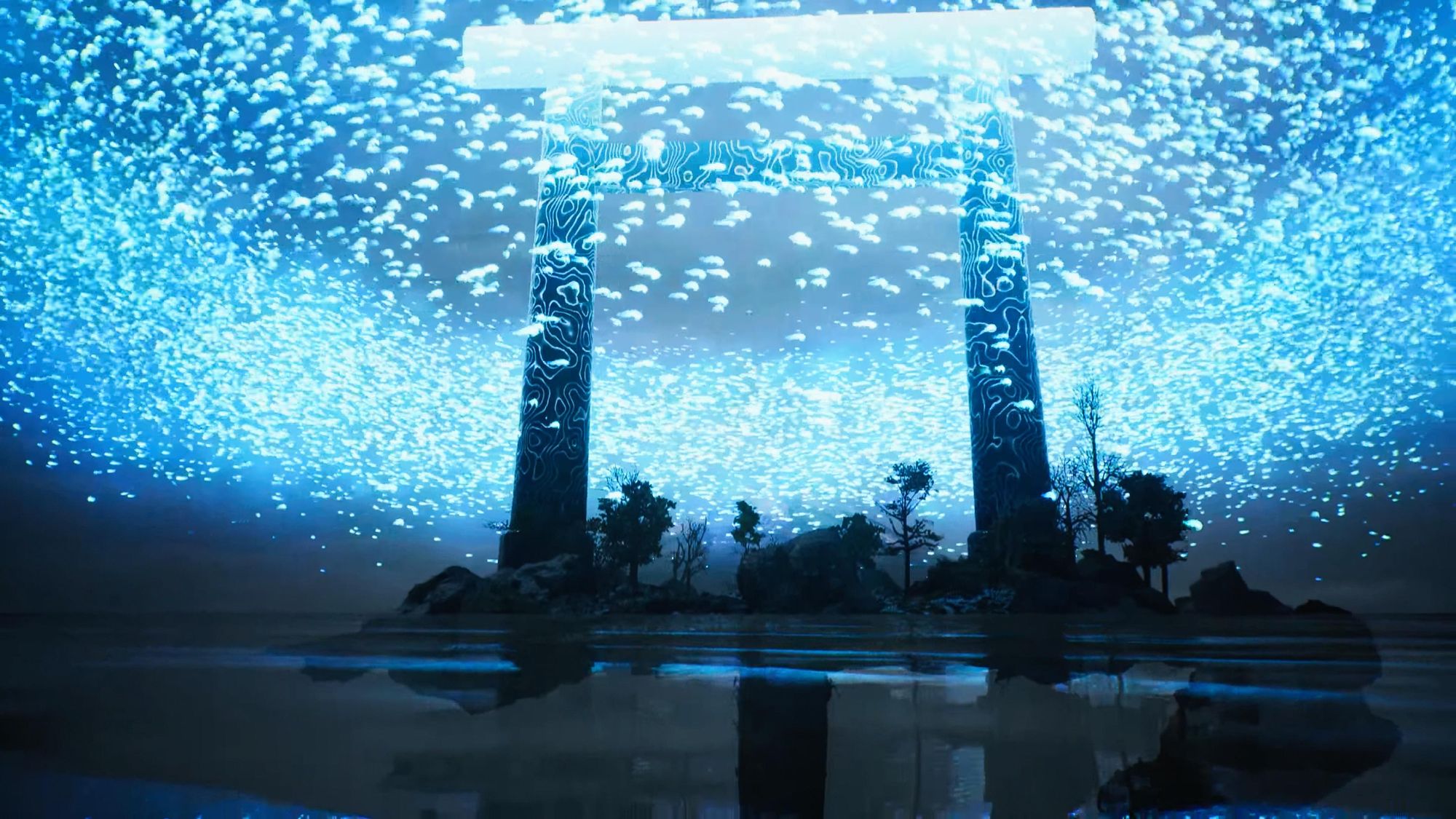
Neon lights burn in Tokyo, catchy jingles and music from nearby stores loop. With the city plunged into an endless night, it wears its nightlife attire loudly. Suddenly, the recorded advertisements go quiet. The sound of drums — the sound of a parade — swells around the corner. The lights shudder and fog rolls in, this portion of the city seeming to mute itself so only this procession is audible. Creatures in the shape of women with newspapers and ads for cheekbones and noses take measured steps in their pencil skirts. Faceless men in suits shuffle forward, backs hunched, grasping their umbrellas. Children in school uniforms jauntily stride along, morbidly missing their heads. With elongated limbs and a face that looks like a mix between a monkey and a bat, a beastly creature joins the Hyakki Yako — the demon parade.
There are two sides to Tokyo found in Ghostwire: Tokyo. One side incorporates folklore and a history of traditions. The other side carries modernization and capitalism. Japanese developer, Tango Gameworks, fuses the two simultaneously, setting up a surreal cityscape for players to explore.
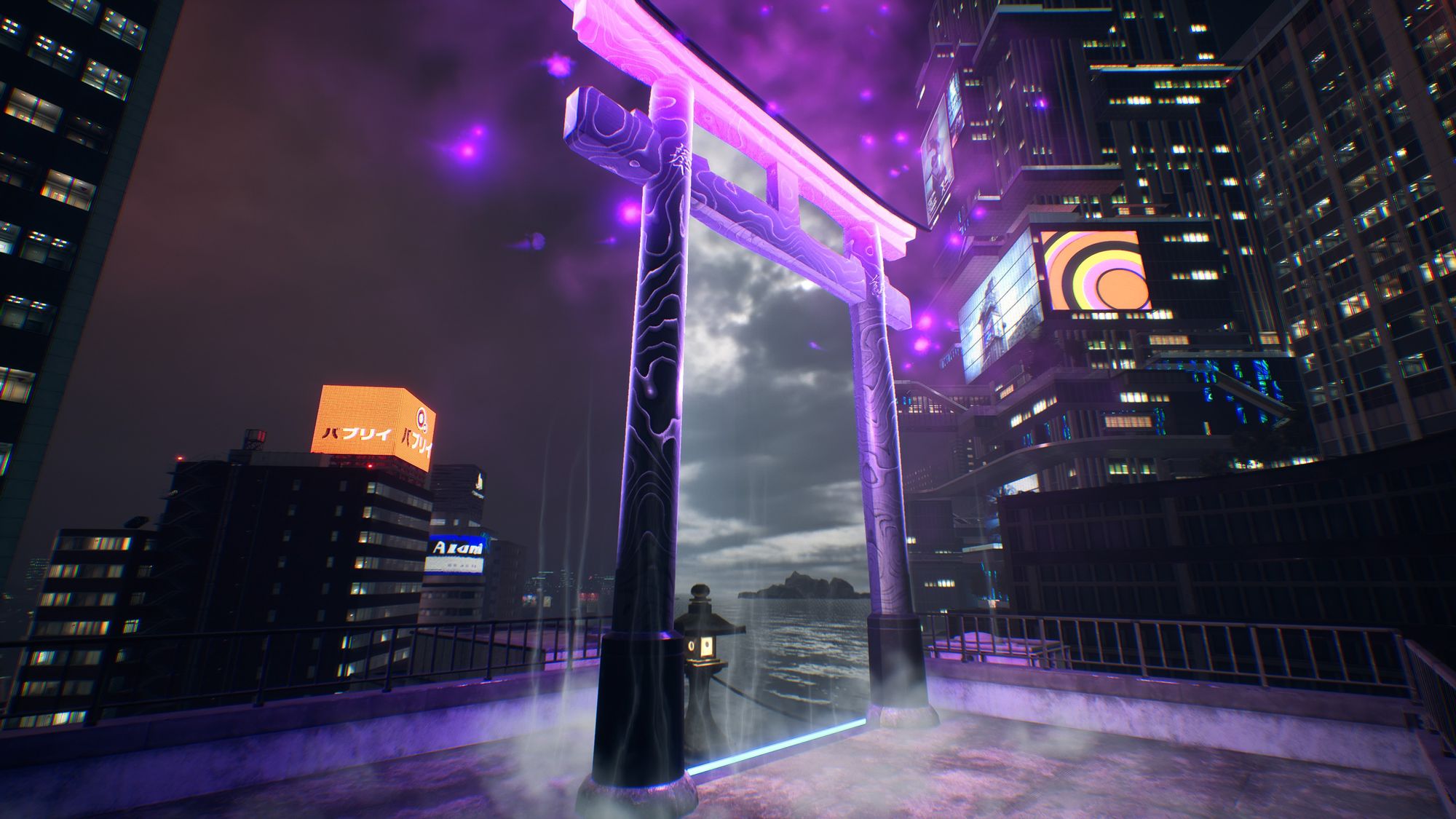
Ghostwire’s story introduces players to a young man, Izuki Akito, who finds himself in a terrible accident in Shibuya while on his way to visit his hospital-bound sister, Mari. On the brink of death, a shadowy entity who calls himself KK weasels himself into Akito’s body. Before Akito can fully comprehend the spirit fighting for ownership or how a portion of his face is being eaten by shadow, a strange fog surges across the screen. People suddenly vanish, devoured by this cloying fog. Clothes and belongings create small piles on the road and sidewalk — the physical leftovers of humanity. Yet Akito remains, to his horror.
Ghostwire has players watching Akito stumble and fumble his way across this contradiction of a city. The lights are still on. Advertisements aggressively promote the latest product or the hottest deal. Restaurants and stores pulsate with upbeat music. Tokyo’s bells and whistles are declaring it is alive, yet its emptiness suggests otherwise.
I didn’t foresee the juxtaposition of clutter and nothingness to be the image that would leave me unsettled.
Ghostwire brings forth various contradictory forces in this fictional rendition of Tokyo, often functioning as commentary on different societal issues (such as unhealthy workplace environments and toxic masculinity), grief and loss, and the inability to move on. Tango Gameworks illustrate the dynamic between these forces through the game’s design, characters, and narrative while highlighting Japanese folklore and urban legends. All of it comes together to create a memorable and nerve-wracking experience navigating the streets of Tokyo.

The Occult on a Contemporary Stage
The developers littered the streets not only with the remnants of humanity, but with great detail and care, real landmarks and locations existing in this virtual Tokyo. You can walk across the Shibuya Scramble Crossing, the epitome of both chaos and harmony with its pedestrians and cars once criss-crossing about. Not too far off is Nonbei Yokocho (Drunkard’s Alley), teeming with small, crowded restaurants and bars. Each location found in the game bears thoughtful homage and respect to Tokyo’s aesthetics and Japanese culture from its temples, the advertisements found plastered on storefronts, to the delicious snacks you can scarf down.
Japan has always held strong ties to its past, known for fusing both tradition and modernity together. The past is resilient despite the towering steel structures and endless vending machines. The Asian Theatre Journal once described Japan as having “ensured the continuation of its ancient arts while at the same time its ability to absorb foreign influences.” Izumi Nakamura, the creative director behind Ghostwire for several years of its development, wished to highlight that intertwinement, but place the spotlight on the occult.
Nakamura has always held a deep love for the horror genre, crediting her father for nurturing it over horror movies and games like Resident Evil. She pursued and continues to pursue that love for the genre and video games, having worked on notable titles such as Okami, Bayonetta, and The Evil Within series and even launched her own studio, Unseen. When Nakamura took the lead on Ghostwire, she envisioned the supernatural and the occult on a contemporary stage.
Just like Shibuya Scramble Crossing, it’s both chaos and harmony.
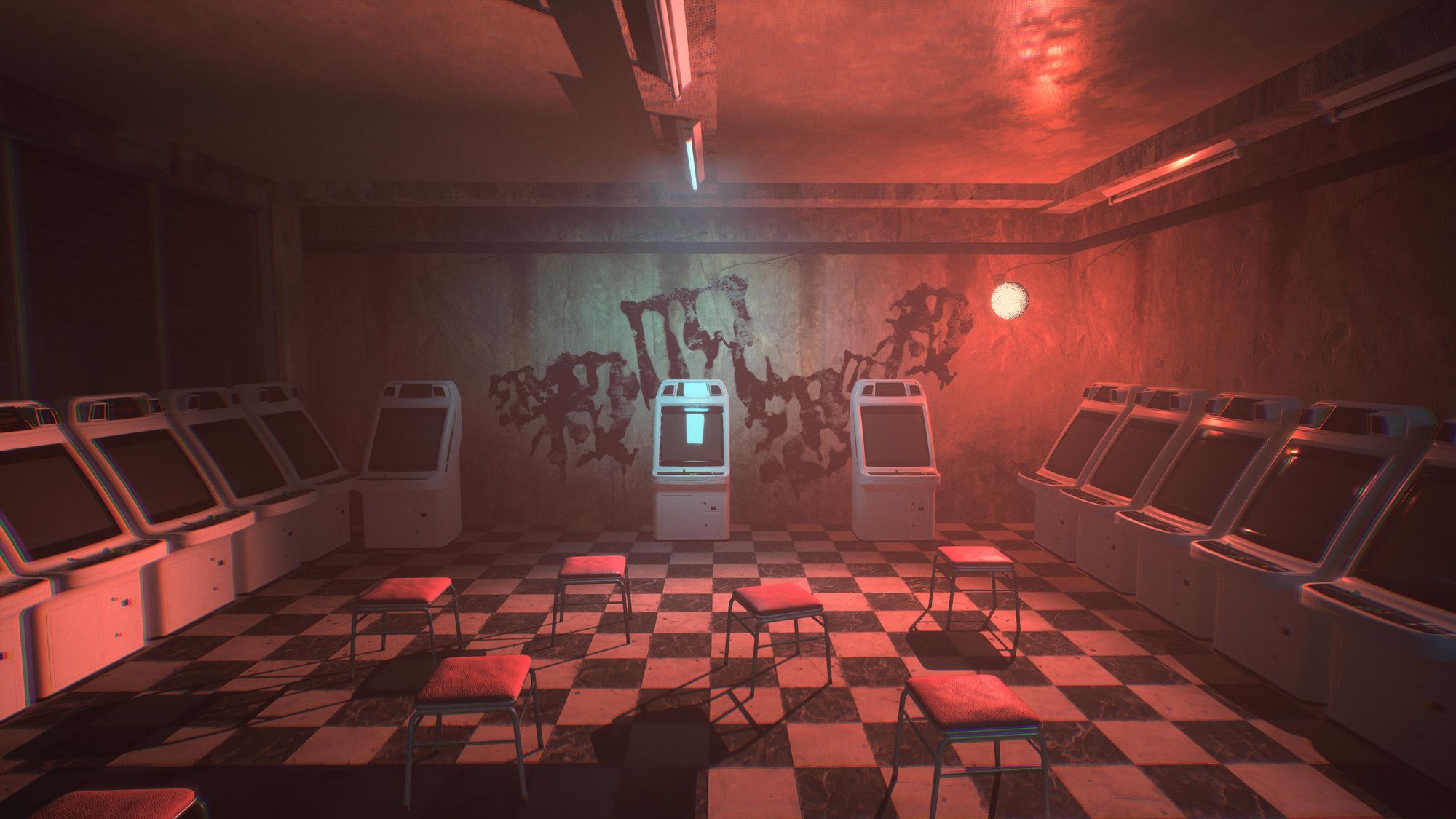
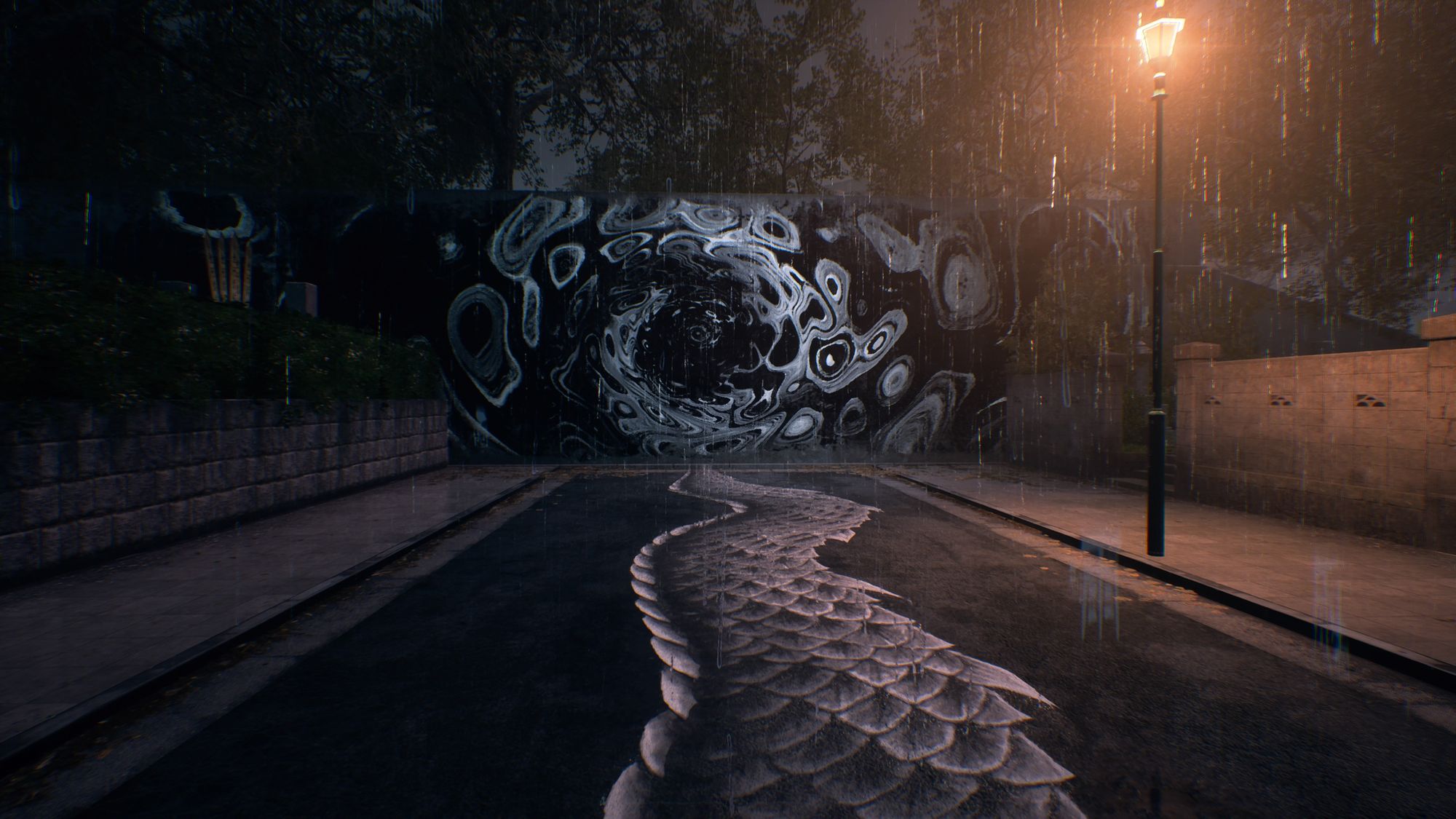
A Playground for the Paranormal
Junya Fuji, the environment designer behind Ghostwire, shared that the city players explore is “directed in a way that allows people to sense the reality of Tokyo. It is created realistically.” He stresses further that having a modern and relatable landscape makes the abnormal and paranormal further stand out.
I found the environmental abnormalities to be more menacing than the Visitors (vicious spirits) and frothing specters coming out of the woodworks. Places that both Akito and KK will recognize and recount memories are now warped with the otherworldly.
Ether (spirit particles) will imitate everyday objects and listlessly hover about, carrying an odd hum until destroyed. Kegare — toxic, paranormal waste — grows in areas rampant with negative energy, attracting crows and Visitors. This waste manifests in a gelatinous form, taking the shape of barren trees, some edges jagged while other branches suspiciously look like stretched out hands. There are even Visitors who can alter the environment about them. Kuchisakes — a Visitor born and embodying frenzied rage, butchering those who cross her path with massive scissors — can leave the surrounding spaces with a rust-like appearance. The subtle blood and rust theme often seen in horror games like Silent Hill always has me rethinking my approach to the decaying street before me.
In Ghostwire, surreal happenings (nekomatas running convenience stores and food stalls, dogs hustling you for food in exchange for summoning an oni, hallucinations of people floating upward with umbrellas) and technological oddities (how is it that the spirits we’re rescuing via phone booth transfer will rediscover their bodies?) go unexplained, happening naturally within the story. Then there are moments where you’re pulled into environments that make it feel as if you’re caught in a dream that sits on a spectrum, with one end being vividly colored and absurd and the other being bleak and nightmarish.
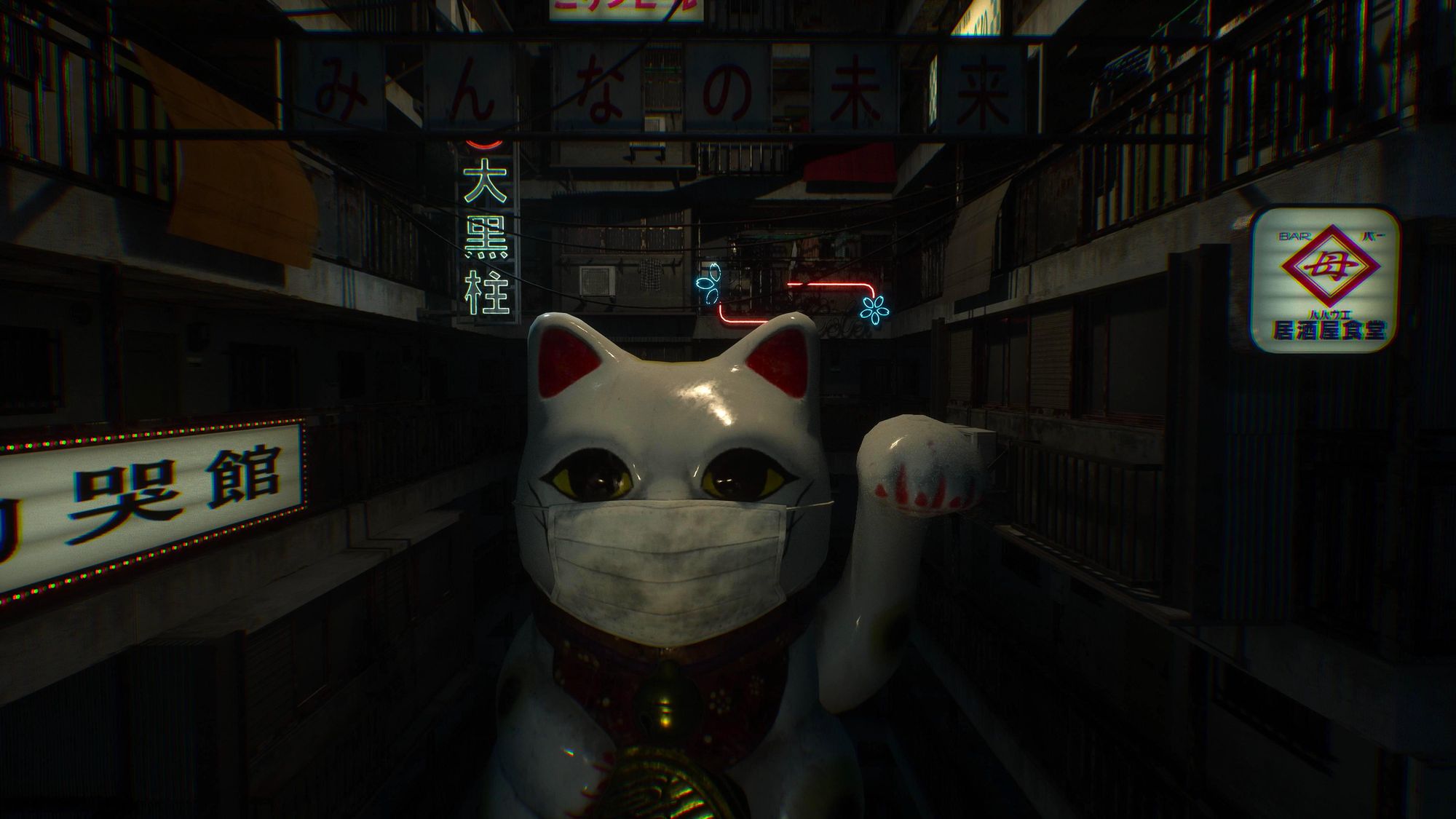
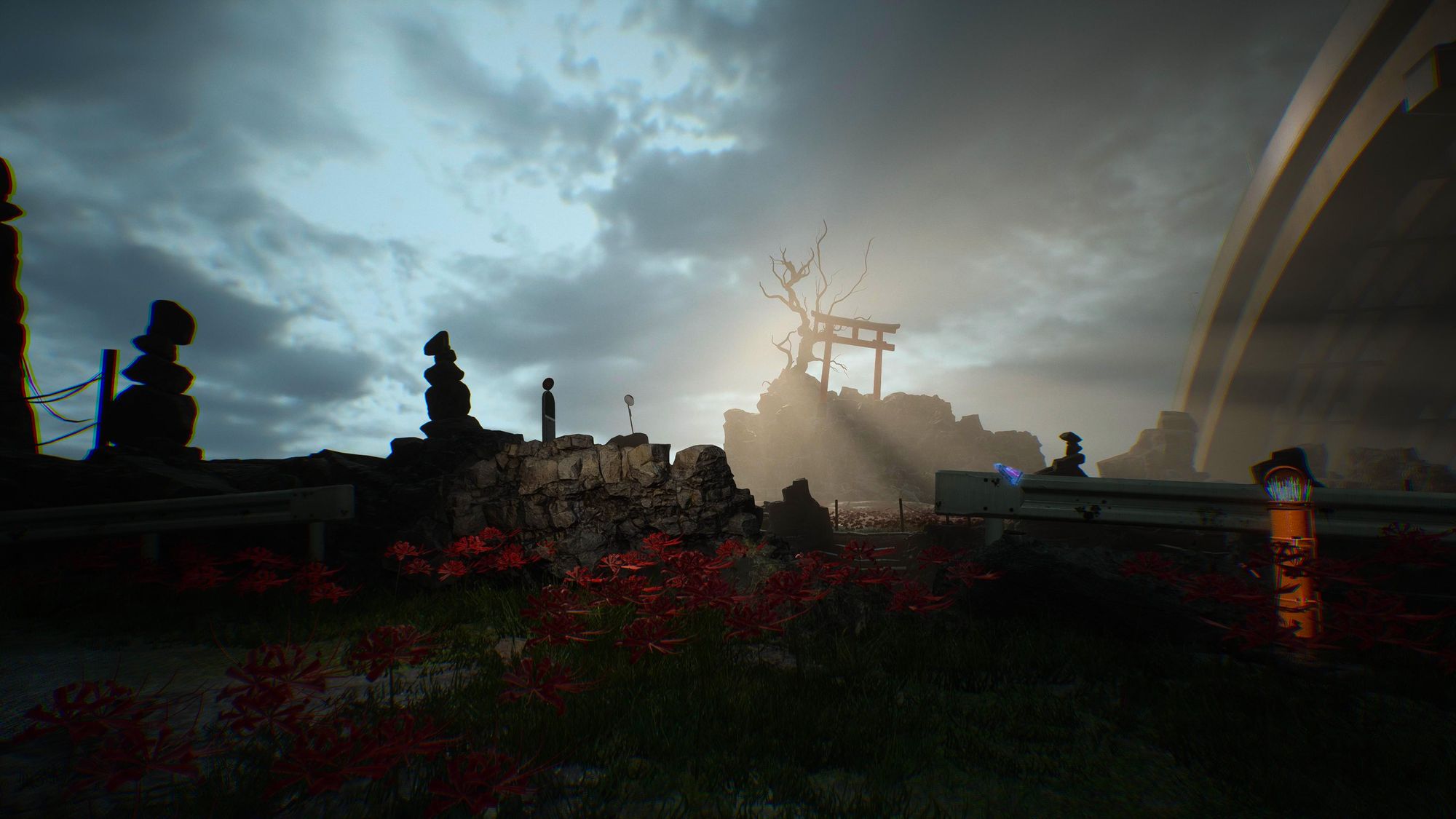
The game features powerful entities and energies that can pull you into these warped, shifting realities. It's here where the Tango Gameworks team absolutely shined, their creativity boundless in these areas.
Dull apartment buildings can suddenly glitch to life with neon signs. They’re unnaturally shoved against each other, but it’s the low, electronic meowing from a massive maneki-neko that truly shows you’ve stepped outside the bounds of normalcy.
I couldn’t help but think of games like Control and 2013’s DmC: Devil May Cry, where developers transformed modern spaces into breathing beings of its own. Inanimate objects — newspapers, flyers, chairs — will violently collect itself and leave exits and entryways inaccessible. Staircases go on forever or abruptly cut itself off, forcing you to find another way forward. Eyes observe you from screens and picture frames before skittering off ahead, using the walls as a pathway. The metal grates used to lock-up storefronts and garbage bins rattle whenever the supernatural are near. Even riding the subway alone invites trouble, leading you to a watery grave banked by piles of trash and leftover text messages of those who never survived the trip.
However, I found certain spaces carried something unique about whoever the host was. In Rinko’s, one of KK’s colleagues, you find bits of her across the twisting landscape. Animal traps used to catch stray cats with Erika, another colleague, litter a few hallways, stills of a cat and Rinko herself surge on a gallery frame, glimpses of her hunched and focused in front of computer monitors, a massive Rinko peering down from us before dissolving into paper — this strange space both hostile and vulnerable, providing insight into KK’s reserved colleague.
Other spaces held the last testament or epiphany of its host. Erika’s (the daughter of the game’s antagonist, Hannya) memory hounds the malevolent spirit that now wears her body. Thrown into a landscape filled with neon ads and arcade machines that glow an angry GAME OVER, we hear what must have been Erika's last words. A drive to fight and resist her father echo around us. The sentiment and the clear signs that Erika lost clash against each other. To add further insult to Erika’s memory, the true form of the malevolent spirit twists both her and her love of cats. It wears the face of a woman, but the body of a cat, yowling as it prowls the space.

These unique levels were successful design-wise and helped provide insight into the cast of characters. However, not everyone featured in the game had an interactive exposition of themselves.
I found myself wishing there were more of these instances, especially for our second lead protagonist, KK, and the game’s antagonist, Hannya. Ironically, when facing with the spirit occupying KK’s body or Hannya, I found the interaction to be devoid of personality compared to other levels. An opportunity felt lost where players could have been racing about echos of KK’s life or glimpsing Hannya cleave himself from his humanity to achieve his goals.
Ghostwire: Tokyo - Prelude, released in March of this year, could serve as platform developers could build off of in providing new stories on KK and the paranormal prior to the disaster via updates. As of now the free visual novel serves as a quick introduction to the Ghostwire universe. Crossing my fingers we'll see more!
Animals and Yōkai Now Run the City
Which oddly enough, I'm absolutely okay with!
It’s not all doom and gloom in the city. With humans abruptly disappearing from the city, other spirits and creatures have stepped in to fill the void. With the help of KK’s paranormal gifts, Akito can interact with the unseen. Not only does spectral vision help him spot yōkais, he can communicate with Tokyo’s animals (and pet them). Dogs miss humans terribly and are eager to reward Akito when he provides food their way. Tokyo’s cats seem to be of two minds: either they contemplate the new power structure in the animal hierarchy or wonder why you’re disturbing them from their nap.

There is another unique cat that makes Tokyo not too lonely. Nekomatas, a type of cat yōkai, have taken over convenience stores, food stalls, and shopping booths. They hover over the cash registers, their speech adorably interwoven with their meowing (“I’ve got a lot of stuff I can trade mew for it!”). There is nothing malicious behind these two-tailed cats, more interested in taking your money. You can even help certain nekomatas in collecting relics across the city, items often carrying historical relevance or lore, easter eggs (a 'cursed videotape' referencing The Ring or Joseph Oda's glasses from The Evil Within), to just straight up concerning (a random bloody knife?!).
Yōkais are cleverly located across the city that opens up side missions and opportunities to bolster your paranormal gifts. Turn to the skies and there are the noisy tengus. These winged creatures can be used to slingshot you up to Tokyo’s rooftops, opening up more areas of exploration. Chasing kamaitachis (flying weasels with sickles for hands) to offering a snack to a zashiki-warashi (takes on the image of a child and can either bring good or bad fortune depending on how you treat it) can lead to obtaining jade-colored magatamas, leading to a chance to access new skills.
I immediately loved the snippets of information that would accompany each newly discovered yōkai or encountered myth. They're brief and informative, just enough to help me understand and appreciate their presence.

Part of the novelty behind Ghostwire is seeing how yōkais and their lore flesh out on a modern stage without losing their otherworldliness. In this Tokyo, you can find tanukis (shapeshifting racoon dogs) pretending to be street signs and vending machines, their bushy tail trailing from behind, giving them away. Kappas (frog-like yōkais) live in sewers and canals, peeking out only when an offered cucumber is near. It makes exploring the city's streets a continuous adventure.
A Haunting Cast
Ghostwire defines corruption as deriving from human pathos, now taking on a physical form across Shibuya. As mentioned before, we’ll see the abnormal manifestations of kegare grow in areas riddled with negative energy. However, strong human emotions can manifest as Visitors. Visitors are human-like in appearance, described as malevolent spirits born out of vices, conflicts, and anguish that the human populace has been stewing in.
You’ll know when one is near when white noise trickles out of your DualSense controller. With a majority of exploration done to the backdrop of ambient noises, the static sound is noticeable, an auditory sign that something strange and threatening is close. It’ll peak into a loud, almost electric whine when you’re too close. When the streetlights about you flare a sickly yellow, know that one has taken notice of you.
Visitors' appearances are unique to the strife they are born from. Rain Slashers are faceless women carrying a ratty red umbrella in business attire, “born from the deep enmity that grows from personal conflicts at the workplace.” Shadow Hunters wear the attire and facade of police officers, but came to be when people “lost sight of what they once wished to protect, and who have become the very thing they once wished to fight.” The paranormal aspects of the game, especially through the cast of Visitors, cleverly embodies the social reality felt in the city.
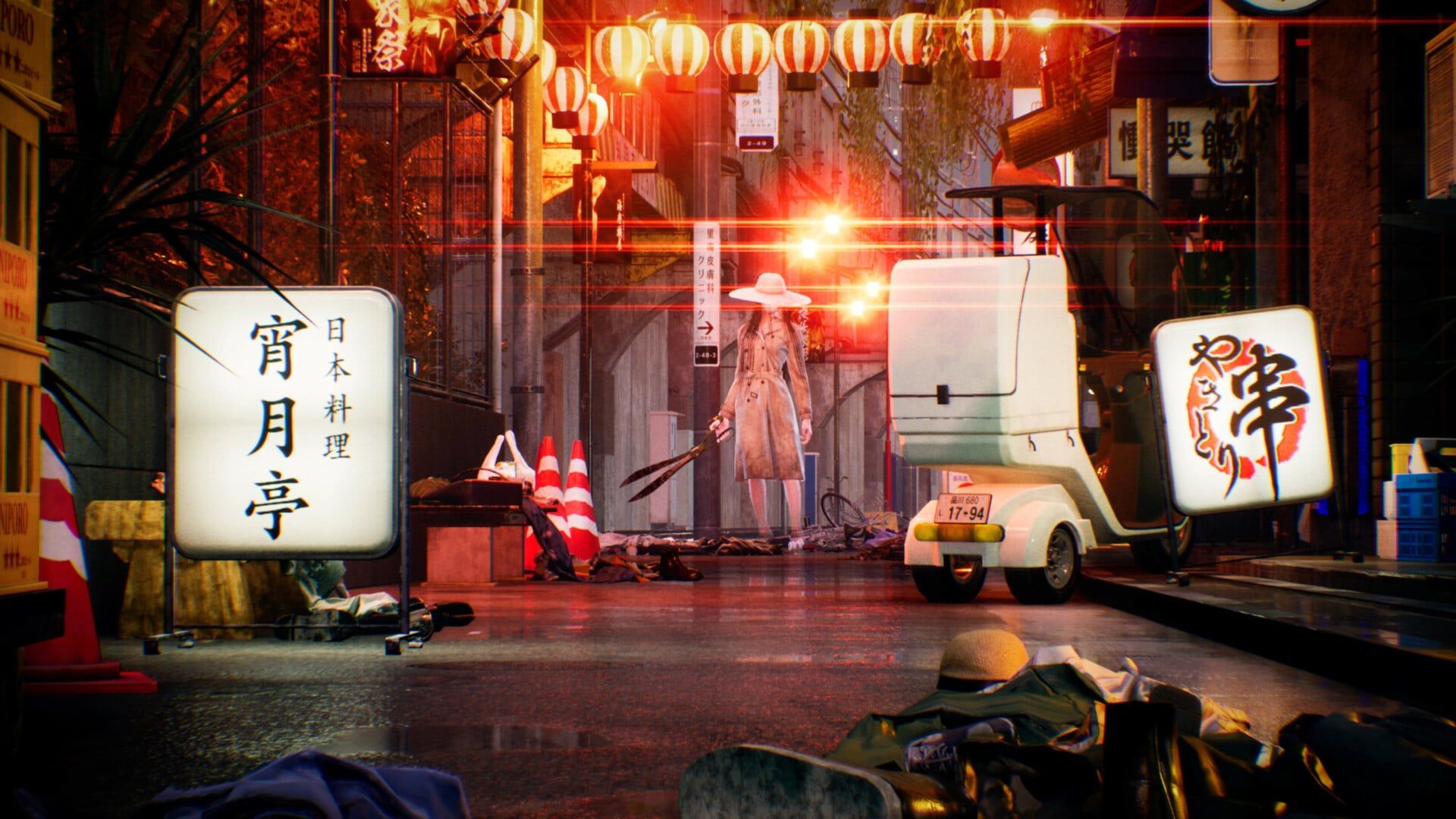

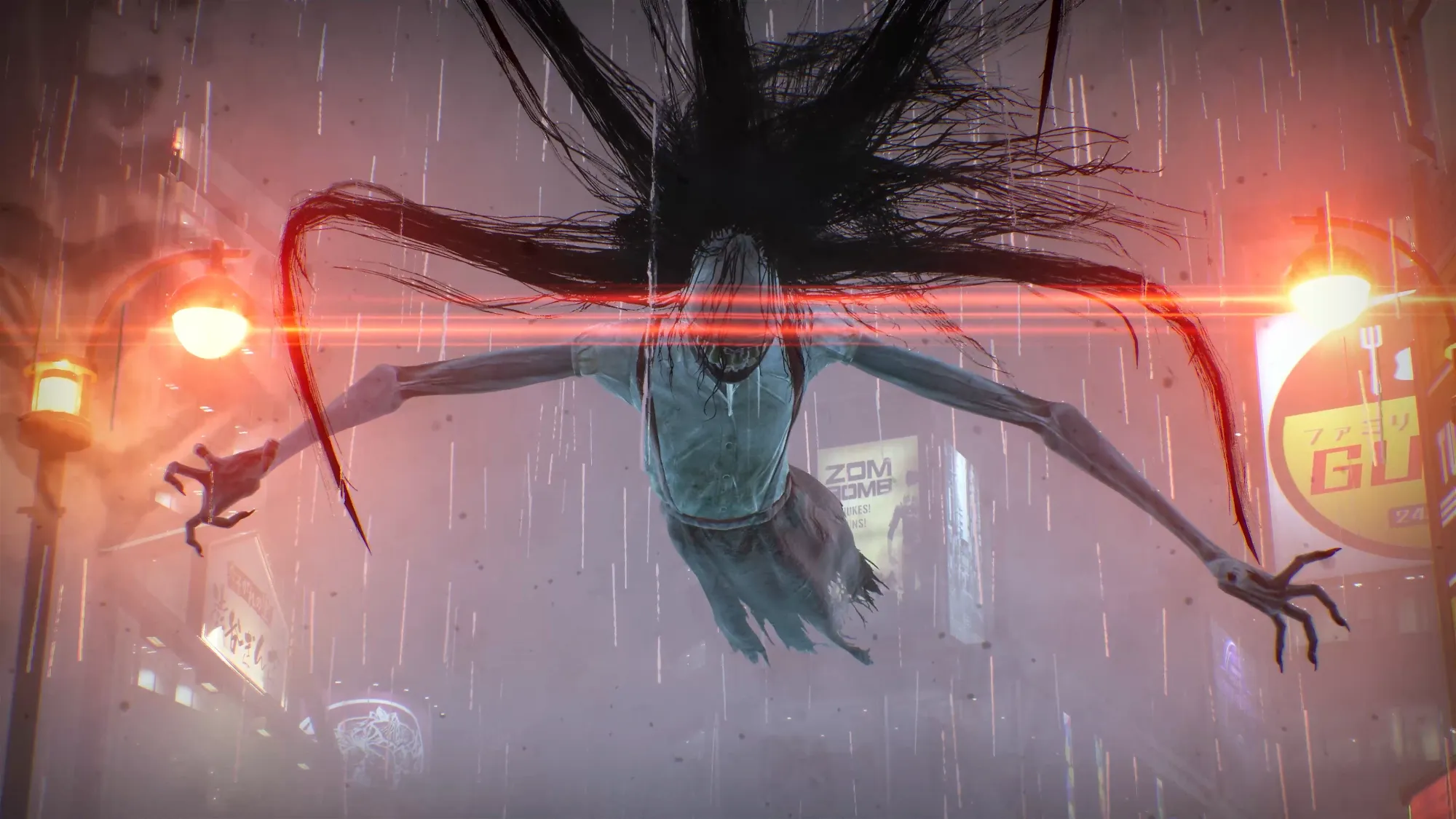
Rugged Walkers, Relentless Walkers, and Rage Walkers seem to embody men whose sense of self depends heavily on how their masculinity is perceived. Their fighting style resembles their oversized rage and insecurity, using their umbrellas as a shield and blunt weapons to pulverize you. Rain Walkers are the most common and show greater intent in snuffing out life than the other Visitors. They’ll knock on doors and peer through windows. They represent the consequences of the rigid and exhaustive workplace culture.
Paper Dolls come from the pressure from society regarding how women should act and appear, spreading the “same negative energy they have been forced to bear.” They wear society’s expectations as newspapers and ads for flesh. Passengers, on the other hand, are born from the despair of having a life predetermined for them by society and family, snuffing out self-expression and exploration. The impact of isolation and what it can do to one’s mental health takes the form of Lamentation, a Visitor with unkempt hair, face overtaken by a distressed mouth, and anxiously hovers in midair for prey to approach.
Some Visitors pay homage to urban legends, such as Kuchisake. This Visitor’s design is based on the ghost of the Slit-Mouthed Woman (Kuchisake-onna). When the wife of a samurai was discovered to be unfaithful, he mutilated her, giving her a Glasgow smile. He wondered, afterwards, who would ever find her beautiful now. The Kuchisake faced in Ghostwire mostly have their faces covered, but wield massive scissors that can sever the connection between Akito and KK. However, there is one Kuchisake dressed in red with her grisly ear-to-ear smile exposed. Best of luck when you run into her.
Not all of the Visitors will appear as adults. There are Visitors who take on the appearance of children, the most common being the Students of Misery and Students of Pain. Anxieties and frustrations experienced by youth manifest in headless students in uniforms. Then there are the Forlorn, taking the shape of a child in a raincoat humming to themselves. They’re often found alone in parks and playgrounds. They’ll panic and summon other Visitors if spotted before fleeing. My heart broke when I found they manifested from the “sorrow of abused children."
These paranormal entities purposely take on a humanoid form and, despite their unsettling nature, they blend in to this Tokyo. They create chaos and yet harmonize with the city. They always existed, wearing school clothes or the usual work attire, but it took the absence of physical bodies – "wrappers for the soul" – to see it.
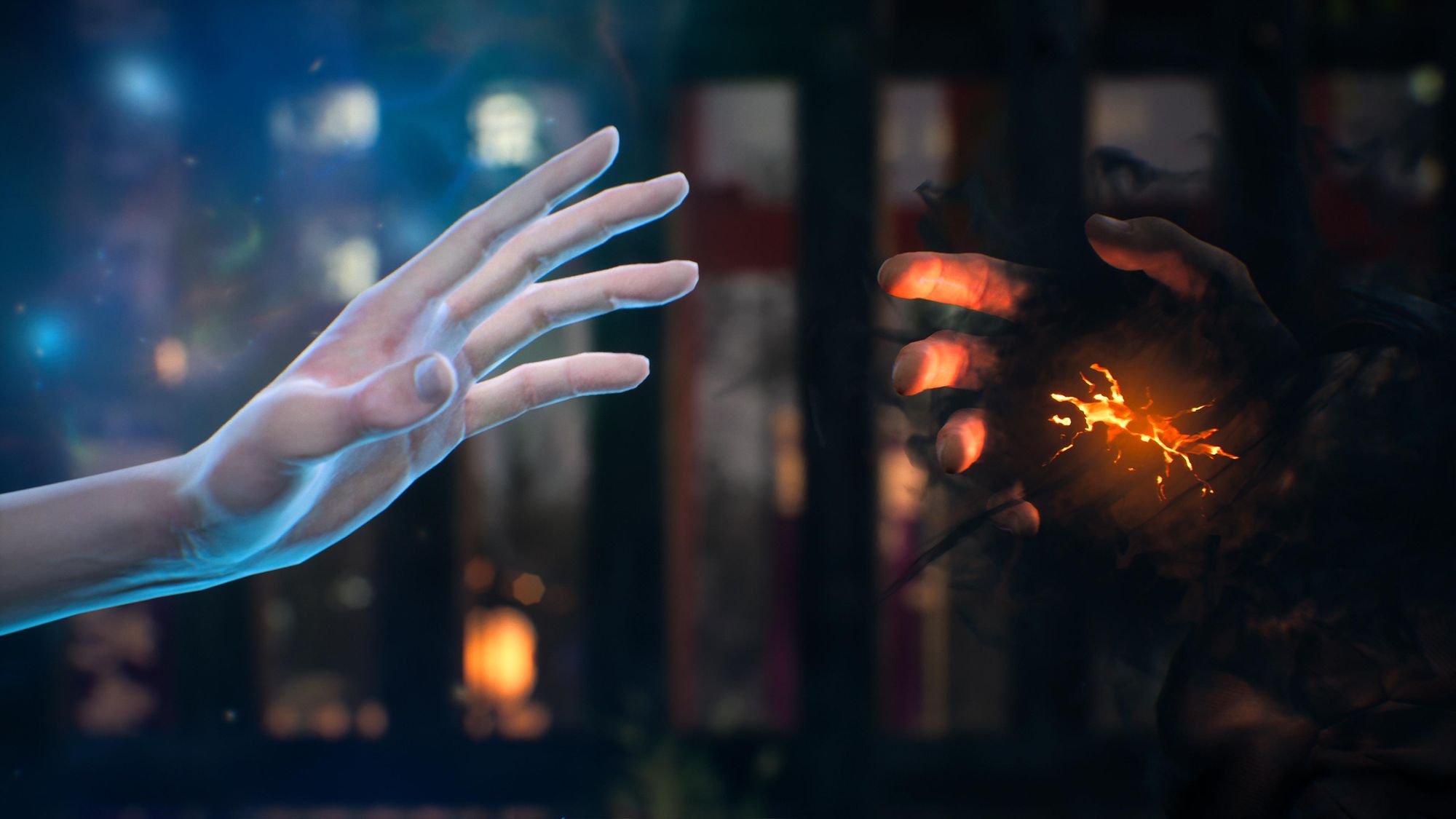
Dealing With Loss
At the center of this paranormal-infused Tokyo are different stories pertaining to loss and the inability to move on. As you explore the city, you can engage in a variety of unique side missions that turn to these themes. With paranormal abilities at Akito’s disposal — such as talismans, Ethereal Weaving, and hand seals — he’s implored by lingering spirits for help.
You can play hide-and-seek with a little boy who has, inadvertently, been trapping others in his imaginative realm. Choosing to continue to play with him will later reveal he’s been refusing to ‘pass on’ because he’s unsure if he’ll be safe. It’s implied he’s often had to hide at home when he was alive due to living in an abusive household. Or you can help reunite two lovers, one cursed by a vengeful spectre in a haunted building, leaving their partner to wonder what happened.
However, the story focuses heavily on Akito’s inability to confront and cope with loss. As the game unfolds, snippets of Akito’s backstory reveal itself. We know his sister is in a coma because of a terrible fire that consumed their home. With his single-minded focus on his sister and rescuing her, it’s hinted at the start that his sister is all he has in his life. Despite Akito's caution in sharing the vulnerable parts of himself to KK, Akito’s emotions often bleed into the world.
The hospital will surge in flames, a woman pressing herself against the window, as if trying to break out. His sister’s voice will flutter through his skull, urging him to help her and wondering where he is. Flashes of memories before the fire take place in a whitewashed landscape, his sister confronting him with a heated, “Nothing’s gonna change if you won’t face it!” Akito closes the door behind him in the memory, leaving his sister behind.
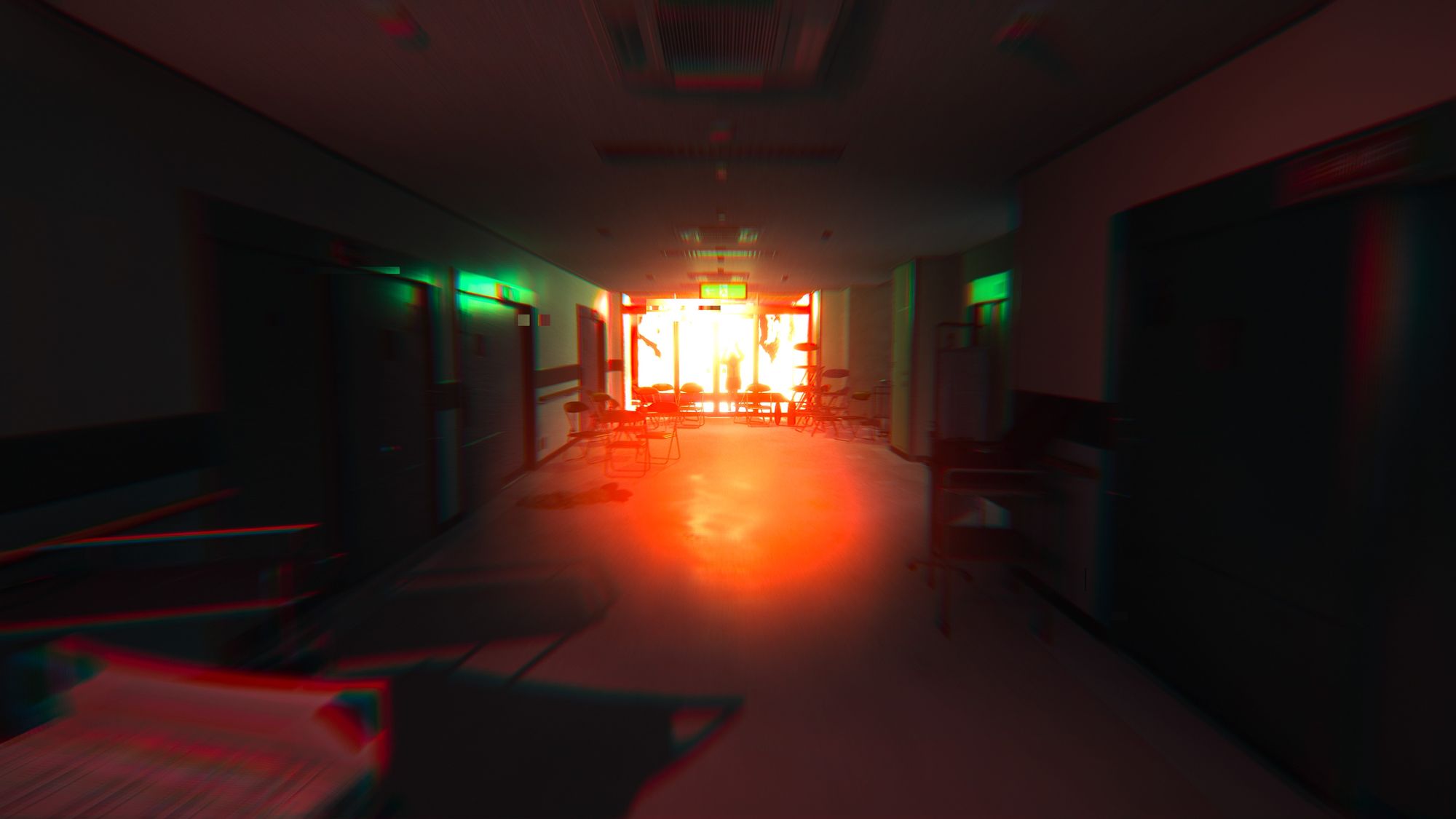
This gnawing guilt is palpable with Kensuke Nishi voicing Akito as the story slowly unravels itself. He feels responsible for Mari ending up in the hospital. I often wondered if what was driving him was truly love for his sibling or a selfish need to absolve himself before the bitter end arrived.
That’s when I realized that Akito fixating on the fire was a red herring. It’s something for Akito to fixate and ruminate over rather than face the true source of his guilt: he emotionally retreated from his sister in the wake of their parents’ deaths. He became more of a stranger and less of a brother in order to maintain a facade that he’s fine. Here was guilt over the faraway relationship and being unable to repair it.
One of my favorite levels that relies heavily on environmental design and imagery being used to punctuate dialogue is the moment where Akito faces the loss and his sister’s tumultuous feelings.
In this realm, doors serve as points of transition, windows into memories and spaces that contain both Akito's and his sister’s thoughts. We hear a younger Akito and Mari head off to elementary school, Akito assuring her he’s here to protect her. The next door is Akito, older, brushing her off, wanting to spend time with his friends instead. I found myself feeling embarrassed for Akito that he’s being exposed as not exactly being the best brother to begin with. Here is the audience who have been assuming from the start that Akito has always been a caring, doting brother.
Each door and space is building up to a series of tragedies, and Akito knows it. Some doors feel laborious to open, and there are a few moments where KK will break his unusual silence to encourage him to continue. He owes it to his sister to hear her thoughts and feelings.
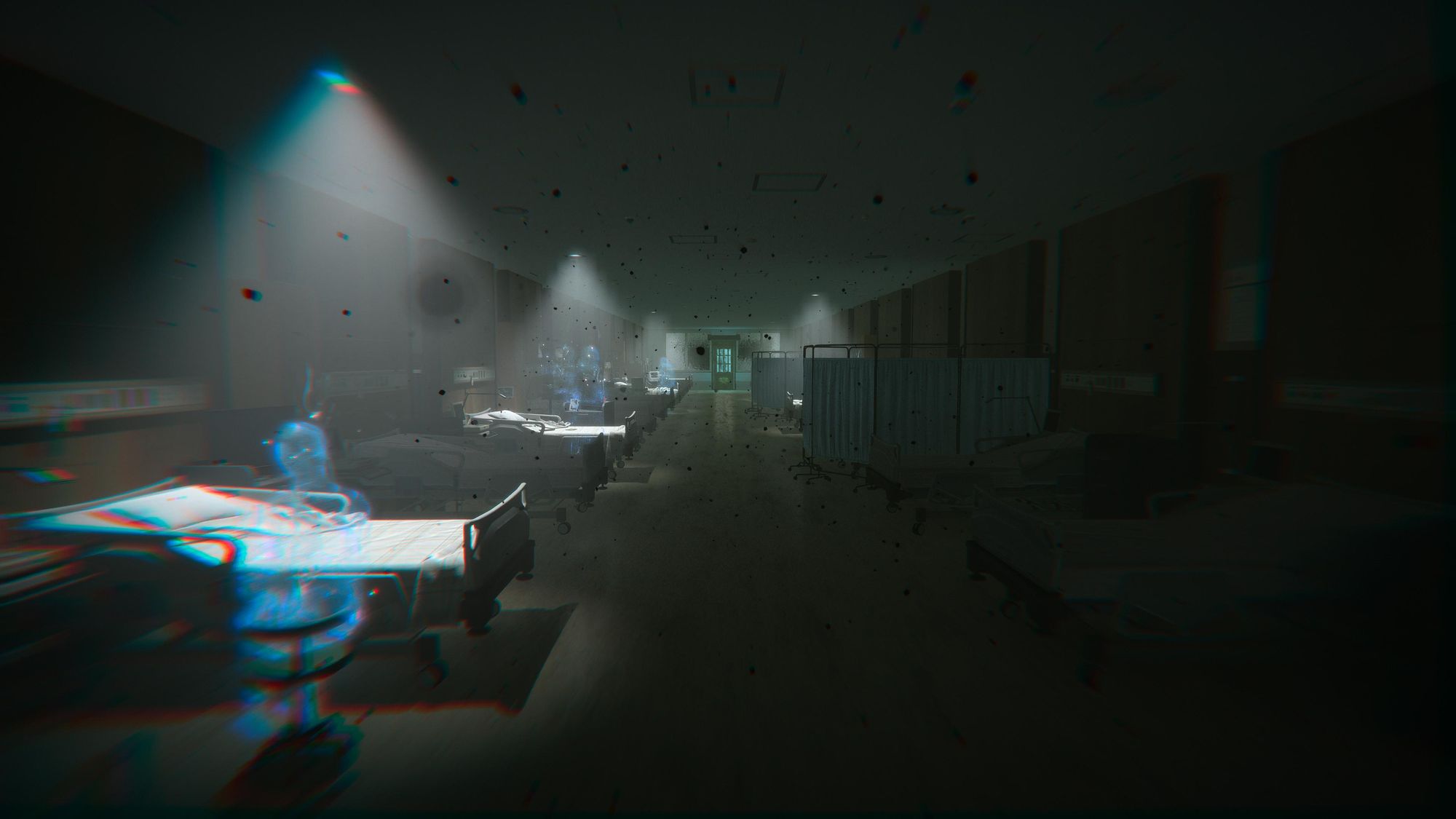
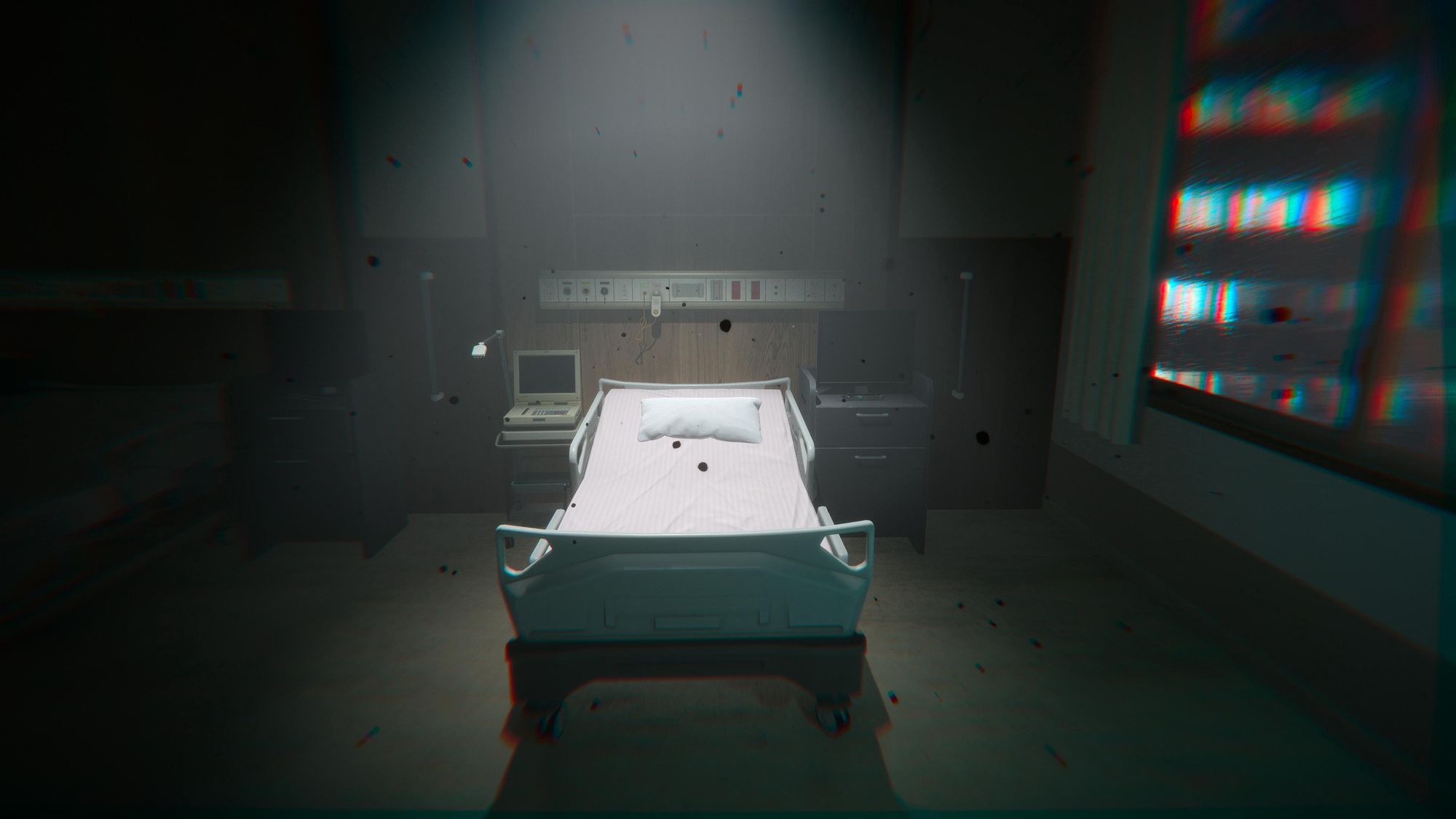
The moment that knocked the wind out of me was the long stretch of hospital beds. The different stages of hospital visits, the silent images of perhaps Mari or Akito in front of a bed, leading up to the last bed that lays empty. It's an image that speak volumes, the only sound being the soft chorus of bells and solitary piano notes in the background.
The door leading out of the hospital is heavy. Mari is obviously struggling with the loss while Akito is stubbornly pushing ahead, talking about “new beginnings.” I understand Akito’s insistence on ignoring the pain of loss and appearing "strong.” I’ve been in his shoes, numbing yourself and pretending everything is fine, but there is a great price to that strategy. The price to this detachment is the relationship with his sister, failing to notice his sister is drowning. Her grief molds itself into a staircase without a bottom, Mari at the precipice of giving up, willing the bottom to arrive – "If I'm just gonna fall... I might as well jump."
It’s moments like these, where developers utilize the environment to show rather than tell the emotions of the cast or to give weight to a character's line, that sold the game for me. It was powerful to see this gradual increase of negative imagery align with Mari’s dwindling hope in a future for herself. Here is Akito, for the first time, truly listening to his sister and ready to be receptive to both her feelings and his own. He won’t run away this time.

Final Thoughts
Even as I come to this point in the piece, I feel I haven’t conveyed enough how visually stunning Ghostwire: Tokyo is or just how well the game captures the merging of the otherworldly and the modern world. The game’s strengths lie in its usage of imagery and the imagination of how the manifestation of serious and overlooked plights appears and act.
I think back to Nakamura’s past interviews regarding one of her goals as a game developer. She spoke of creating content that shared “how cool Asian cities and culture” is to a global audience. Through Ghostwire, the Tango Gameworks team created a captivating love song of Tokyo and Japanese folklore. It’s a song that left me wanting to explore and learn more.
Ghostwire: Tokyo - Prelude opens the potential to further explore the city and its paranormal residents. While Akito’s story has ended, I still wonder about KK and his investigative coworkers. So much remains unexplored about the game’s other main protagonist, the narrative feeling incomplete. I know many players — myself included — would be excited to revisit the streets of Tokyo leading up to the main story.
If you’re interested in exploring Tokyo without the crowd (literally) and when the barrier between reality and the supernatural is paper thin, then Ghostwire is for you. Despite the Visitors and the morbid piles of clothes littering the street, the city is a sight to behold. I couldn’t stop taking pictures and enjoying the sudden pouring of rain, listening to the soundtrack of Tokyo at night, and Akito walk through puddles. However, if you happen to hear the swelling of drums, don't linger for too long. The participants of the Hyakki Yako don't take too kindly to intruders.
